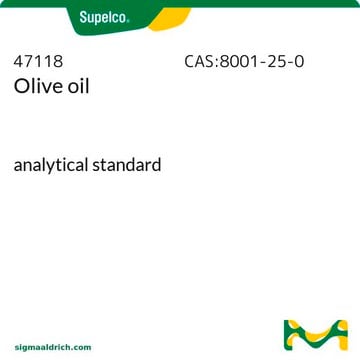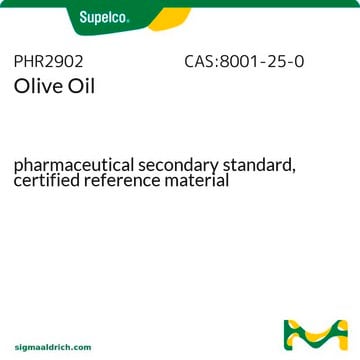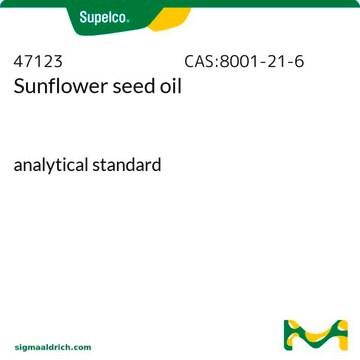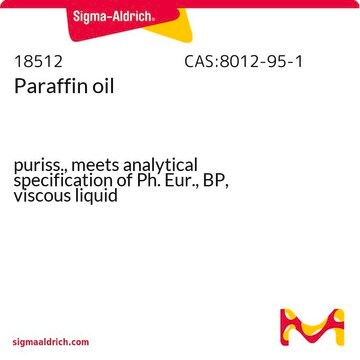75343
Olive oil
tested according to Ph. Eur.
Synonym(s):
Olivae oleum virginale
Sign Into View Organizational & Contract Pricing
All Photos(1)
About This Item
Recommended Products
Agency
USP/NF
tested according to Ph. Eur.
Quality Level
form
viscous liquid
density
0.910 g/cm3
functional group
ester
oleic acid
lipid type
oils
shipped in
ambient
storage temp.
room temp
Looking for similar products? Visit Product Comparison Guide
General description
Olive oil is extracted from the fruit of the olive tree. Oleic acid, phenolic compounds, and squalene are the key constituents of olive oil.
Application
Olive oil has been used:
- as a source of energy and carbon in the medium for lipase and biosurfactant production
- in pharmacological preparations of exemestane and estradiol
- in preparation of wax-oil lubricants to reduce the shear between skin and personal protective equipment (PPE)
Biochem/physiol Actions
Olive oil has a wide range of therapeutic and culinary applications. It is used as a source of fat in Mediterranean food. The anti-atherogenic effects of olive oil can contribute to the low rate of cardiovascular mortality. Long-term consumption of olive oil is proven to be good for human health and it aids in preventing breast cancer, and type 2 diabetes mellitus.
The health benefits of olive oil result from its higher proportion of monounsaturated fats, as well as its antioxidant constituents: hydroxytyrosol, oleuropein and oleocanthal.
Storage Class Code
10 - Combustible liquids
WGK
WGK 1
Flash Point(F)
235.4 °F - closed cup
Flash Point(C)
113 °C - closed cup
Personal Protective Equipment
dust mask type N95 (US), Eyeshields, Gloves
Choose from one of the most recent versions:
Already Own This Product?
Find documentation for the products that you have recently purchased in the Document Library.
Alexandra Foscolou et al.
Maturitas, 118, 60-66 (2018-11-13)
The potential health benefits of olive oil consumption, particularly within the context of the Mediterranean diet, have been extensively investigated. However, its specific health benefits remain to be confirmed. The aim of the present work is to review the scientific
Kian Kun Yap et al.
Scientific reports, 11(1), 11537-11537 (2021-06-04)
Prolonged use of tight-fitting PPE, e.g., by COVID-19 healthcare workers leads to skin injuries. An important contributor is the shear exerted on the skin due to static friction at the skin-PPE interface. This study aims to develop an optimised wax-oil
Emily Waterman et al.
Alternative medicine review : a journal of clinical therapeutic, 12(4), 331-342 (2007-12-12)
The olive tree, Olea europaea, is native to the Mediterranean basin and parts of Asia Minor. The fruit and compression-extracted oil have a wide range of therapeutic and culinary applications. Olive oil also constitutes a major component of the "Mediterranean
Shani Poleg et al.
Translational psychiatry, 11(1), 524-524 (2021-10-15)
Autism spectrum disorder (ASD) is a neurodevelopmental disease with a wide spectrum of manifestation. The core symptoms of ASD are persistent deficits in social communication, and restricted and repetitive patterns of behavior, interests, or activities. These are often accompanied by
María-Isabel Covas
Pharmacological research, 55(3), 175-186 (2007-02-27)
Olive oil is the primary source of fat in the Mediterranean diet which is associated with a low mortality for cardiovascular disease. In spite of this, data concerning olive oil consumption and primary end points for cardiovascular disease are scarce.
Our team of scientists has experience in all areas of research including Life Science, Material Science, Chemical Synthesis, Chromatography, Analytical and many others.
Contact Technical Service







